#architecture visualization techniques
Explore tagged Tumblr posts
Text

#3D architectural walkthroughs#benefits of 3D walkthroughs#architecture visualization techniques#immersive design experiences#architectural rendering software#virtual reality in architecture#interactive design presentations#client engagement in architecture#architectural design tools#3D visualization for real estate.
1 note
·
View note
Text
Revolutionize Your Art with Leonardo AI!
Leonardo AI is revolutionizing artistic creation with its advanced algorithms that transform real-world ideas into stunning masterpieces. This dynamic platform empowers us to design imaginative game assets, including characters, artifacts, landscapes, conceptual visuals, and intricate architectures.
By merging cutting-edge technology with our creative fervor, Leonardo AI enables artists and designers to bring their visions to life. It injects depth and vibrancy into our projects, making it perfect for those looking to elevate their creative endeavors. Discover how this AI-driven toolset offers an unparalleled environment for artistic innovation!
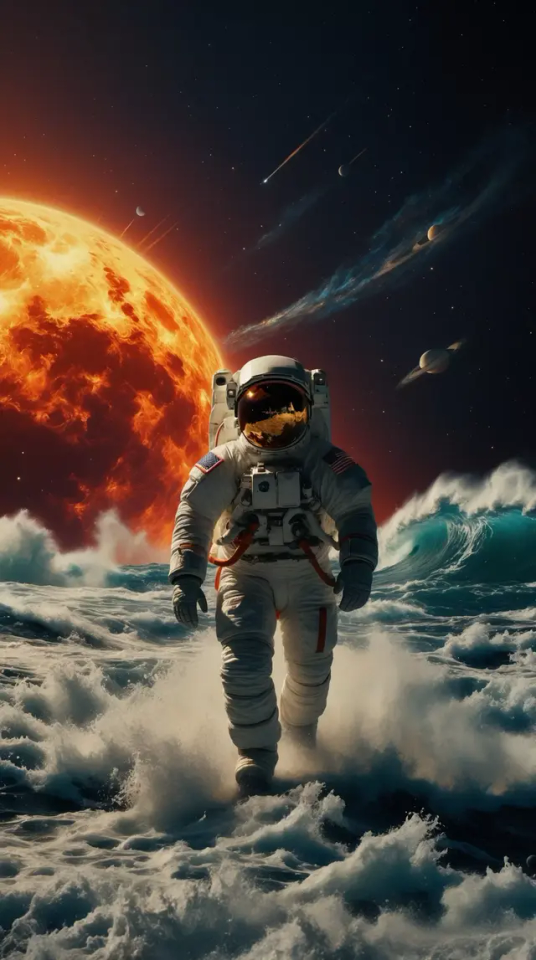
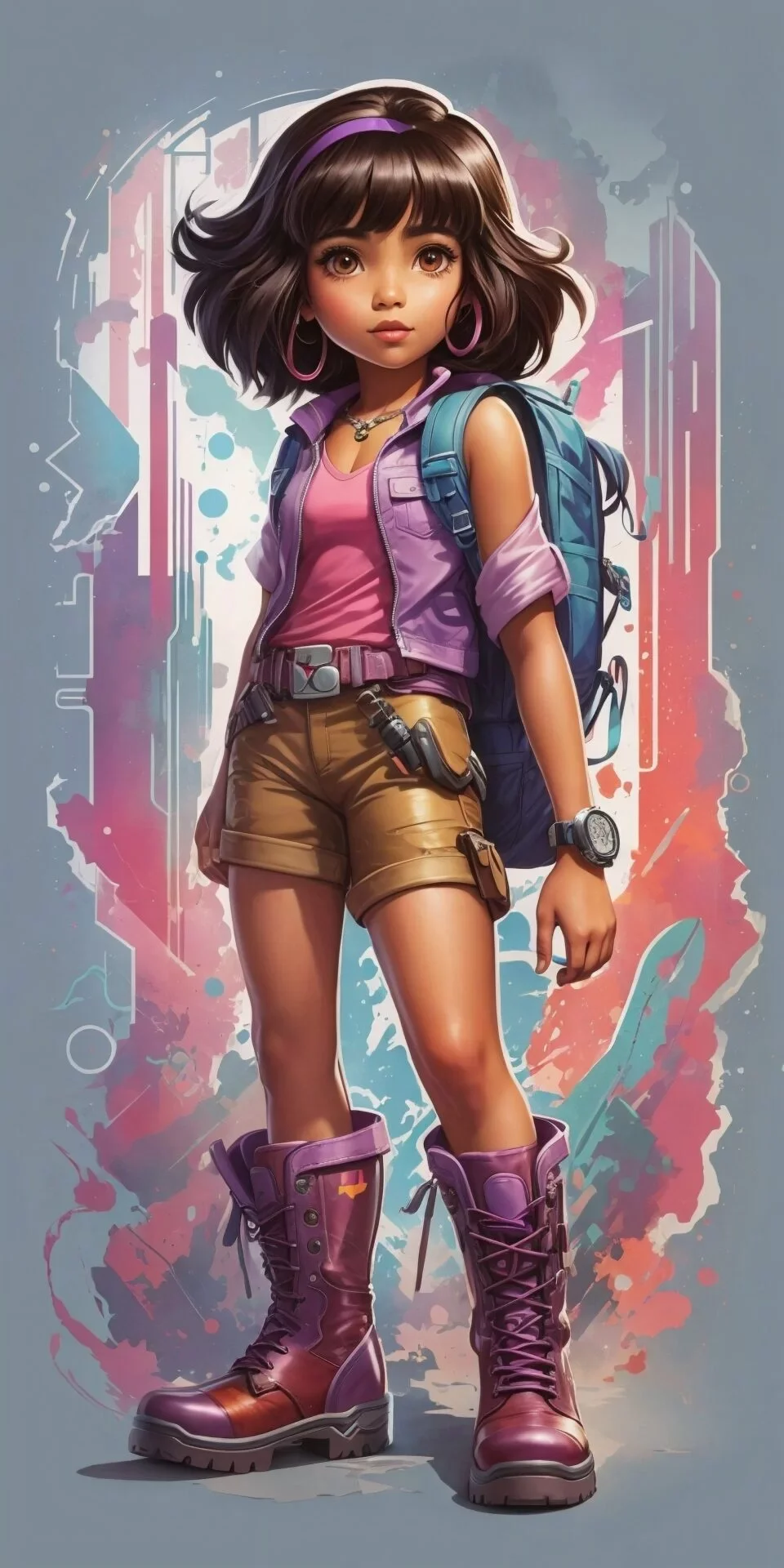
#LeonardoAI #ArtisticInnovation
#Leonardo AI#artistic revolution#creative tools#AI algorithms#game assets#character design#digital art#artistic masterpieces#innovative platform#creative projects#landscape design#architecture design#imaginative visuals#artistic innovation#AI creativity#design software#elevate creativity#vibrant art#concept art#technology and art#art community#digital creators#AI art tools#artistic expression#creative empowerment#visual storytelling#art techniques#design inspiration#future of art#unleash creativity
2 notes
·
View notes
Text
Bringing Imagination to Life with Industry-Leading 3D Movie Creation
3D Rendering Pro transforms your ideas into breathtaking visual narratives with a full suite of CGI, animation, and virtual production services. We cater to filmmakers, advertisers, and content creators who seek uncompromising quality and artistic integrity. Central to our offering is 3D movie creation, where our creative engineers and animators turn complex scripts into vivid, animated sequences that captivate and engage. Our studio delivers everything from pre-visualizations and 3D storyboards to hyper-realistic character animations and environmental dynamics. We work with the latest rendering engines and animation tools to achieve cinematic brilliance and frame-perfect accuracy. Whether it's a stylized animation or a realistic VFX scene, we ensure that every second of your movie adds emotional weight and visual appeal. Choose 3D Rendering Pro to turn your imagination into on-screen reality.

#3d animator#3d animation services#3d model#3d modeling#3d animation company#3d render#3d animation#3d animated film#3d rendering services#3d movies#3d modelling#3d rendering#3d reality#3d art#3d animated animals#3d visualization#3d artwork#3d modeling services#2d animator#2d art#2d animation#2d animated film#2d animated video#3d interior rendering#interior design#interior architecture#exterior#architecture#3d exterior design#visualization techniques
0 notes
Text
Landscape Designs for 3D Exteriors Rendering techniques have a significant impact on property value by enhancing both aesthetic appeal and functional utility.
3D landscape designs extend far beyond the fundamental layouts of outdoor residential improvements. They provide a vivid and detailed representation of nature’s artistry, showcasing an abundance of intricate features that captivate and enliven the viewer.
#Landscape Designs for 3D Exteriors Rendering#3D landscape designs#3D Exteriors Rendering techniques#3D Architectural Visualization Company USA#JS Engineering#3D Rendering Services#3D Exteriors Rendering
1 note
·
View note
Text
recent realization has been just how much of rgu is based on soviet art. we all know by now how ohtori's warping architecture is inspired by constructivism


but apart from that, the thing that makes rgu's cinematography special—it's usage of esoteric images to create visual new meanings + it's repeated shots of lined up objects—is so clearly Eisenstein






rgu directly utilizes Eisenstein's theory of montage—and it's my favorite usage of it too. it feels like the technique was created ex professo for rgu's cinematography. i could think of no better use for it. that girl sure is revolutionary.
#rgu#revolutionary girl utena#it's hard to understand the montage thing through screenshots cause#you need to be familiarized w eisensteins work ig#and his usage of montage#but I promise once you watch battleship potemkin or october it's just. so clear#that this is where rgu gets it's visual language#and it gives the Revolutionary a new meaning
2K notes
·
View notes
Text

#3d architectural visualization#3d render#visualization techniques#visualization#3d animation#3d reality#real estate solutions#real estate agent#real estate photography
1 note
·
View note
Text
Task Manager App: Effortlessly Develop One
Create a Task Manager app using C# WPF and the MVVM pattern. #WPF # Tutorial #MVVM #C-Sharp #Development #Developer #CoderTrend
Using C#, WPF and the MVVM architecture to create a stunning and Useful Task Manager Application Welcome to our comprehensive series where we delve into the creation of a sophisticated Task Manager application using WPF (Windows Presentation Foundation). This journey is not just about building an application; it’s an exploration into the robust capabilities of C# and WPF, crowned with the…

View On WordPress
#.NET Development#Advanced C Techniques#C Programming#Code Efficiency#Coding for Beginners#Desktop Application Development#Model-View-ViewModel#MVVM Pattern#Scalable Software Design#Software Architecture#Task Manager App#UI/UX Design#Visual Studio Tips#Windows Application Development#WPF Tutorial
0 notes
Text
𝐃𝐎𝐒𝐒𝐈𝐄𝐑 𝟎𝟎𝟏 here is my latest dossier template! designed to help you explore and develop your character in depth! please, like or reblog if you intend on using.
BASICS
Full Name:
Known Alias(es):
Age:
Gender:
Birthday:
Heritage:
Religion:
Sexual & Romantic Orientation:
Status: (Alive, deceased, missing, verse-dependent, etc.)
Residencies: (List properties, safe houses, or frequently visited locations.)
Highest Education Level:
Occupation(s): (Primary career, side ventures, or any criminal affiliations.)
PHYSICAL EXAM
Facial Features:
Faceclaim: (Optional visual reference)
Voice: (Describe tone, accent, speaking style, and cadence.)
Voiceclaim: (Optional reference for speech patterns or voice tone.)
Eyes:
Hair:
Body Type:
Distinguishable Marks: (Scars, tattoos, or unique features.)
Weight:
Height:
MENTAL EVALUATION
Mental Illnesses (if applicable): (Diagnosed or speculated disorders.)
Psychological Profile: (Core motivations, fears, triggers, etc.)
Positive Traits: (List at least four.)
Negative Traits: (List at least four.)
Alignment Type: (D&D alignment or custom moral code.)
Personality Type (MBTI):
Phobias: (If any.)
Mannerisms: (Unconscious habits, nervous tics, or common gestures.)
Hobbies & Interests: (Leisure activities, intellectual pursuits, or obsessions.)
STRATEGIC ANALYSIS
Combat Style: (Brutal, strategic, erratic, refined?)
Weapon of Choice: (Blades, firearms, improvised weapons, etc.)
Hand-to-Hand Combat Proficiency: (Strengths & weaknesses in close combat.)
Tactical Strengths: (Leadership, adaptability, patience, etc.)
Tactical Weaknesses: (Blind spots, arrogance, temper, emotional ties.)
Signature Techniques: (Favored moves or combat tricks.)
Pain Tolerance: (How well do they withstand pain or injuries?)
Defensive Skills: (Escape artist? Counter-fighter? Tank?)
AFFILIATIONS & RELATIONSHIPS
Family: (List members and relationship status.)
Allies & Associates: (Trusted confidants or powerful connections.)
Rivalries: (Ongoing personal or professional conflicts.)
Enemies: (Those actively working against them.)
Romantic History: (List known or rumored relationships.)
Notable Friends: (True friendships vs. strategic alliances.)
HABITS & LIFESTYLE
Daily Routine: (Structured, chaotic, or ritualistic?)
Diet & Nutrition: (Healthy, indulgent, restrictive, etc.)
Exercise Habits: (Type and frequency of physical activity.)
Grooming Habits: (Meticulous, rugged, or indifferent?)
Substance Use: (Drinks? Smokes? Drugs? How frequently?)
Sleep Patterns: (Well-rested or chronically exhausted?)
Personal Aesthetic: (Style, wardrobe, and preferred fashion choices.)
Favorite Books:
Favorite Music Genres:
Favorite Art/Architecture: (If applicable.)
SPECIAL NOTES & CHARACTER LORE
insert here
#rp help#character help#rp character help#dossier template#character stat template#dossier:template#mine:template
382 notes
·
View notes
Text
Enhancing Client Engagement with Immersive 3D Walkthroughs in Architecture

Explore how immersive 3D walkthroughs transform client engagement in the architectural process. These interactive platforms allow clients to actively explore designs, enabling architects to gather valuable feedback. This collaboration ensures that the final outcome meets client expectations, ultimately enhancing satisfaction and fostering stronger relationships.
#3D architectural walkthroughs#benefits of 3D walkthroughs#architecture visualization techniques#immersive design experiences#architectural rendering software#virtual reality in architecture#interactive design presentations#client engagement in architecture#architectural design tools#3D visualization for real estate
1 note
·
View note
Text














Пейзажи колумбийской художницы Marcelina Posada.
Марцелина де Посада (Marcelina Posada) — колумбийский художник. Родилась в Медельине, Колумбия, в семье с несколькими поколениями художников. Окончив школу, Посада переехала в “Афины Южной Америки” — Боготу. Изучала архитектуру в католическом университете Хавериана, специализировалась на визуальном выражении и благоустройстве.
Изобразительное искусство изучала в одном из самых знаменитых художественных институтов Боготы — Кампусано Мьюзеум Гомес Академии. Затем, в течение более десяти лет, она изучала живопись под руководством многих мировых художников, совершенствуя своё мастерство и приемы рисования с использованием различных материалов, таких как уголь, акварель, акрил и масло. С 2004 года она живет в Ванкувере с мужем и тремя взрослыми детьми. Ее картины много раз становились частью различных латиноамериканских художественных выставок. В настоящее время работы Марцелина можно увидеть на выставке в художественной галерее Ванкувера, где она представлена в постоянной экспозиции галереи.
Landscapes by Colombian artist Marcelina Posada.
Marcelina de Posada is a Colombian artist. She was born in Medellin, Colombia, into a family with several generations of artists. After finishing school, Posada moved to the “Athens of South America” - Bogotá. She studied architecture at the Catholic University of Javeriana, specializing in visual expression and landscaping.
She studied fine arts at one of the most famous art institutes in Bogotá - Campusano Museo Gomez Academy. Then, for more than ten years, she studied painting under the guidance of many world artists, improving her skills and drawing techniques using various materials such as charcoal, watercolor, acrylic and oil. Since 2004, she lives in Vancouver with her husband and three adult children. Her paintings have been part of various Latin American art exhibitions many times. Marcelin's work is currently on display at the Vancouver Art Gallery, where it is featured in the gallery's permanent collection.
Источник:/www.risunoc.com/2020/08/kolumbijskij-hudozhnik-marcelina-posada.html, ://artogalleria.com/en/artist/marcelina-posada-2/artworks?current_page=1&page_size=60&sort= featured &seed=10056407.
#painting#artist#Marcelina Posada#Contemporary / Modern#Expressionist#Landscape#Architecture#sea and sky#boats#mountains and forest#cityscape#canvas and oil#живопись#художник#Марцелина де Посада#Современный / Модерн#Экспрессионизм#Пейзаж#Архитектура#городской пейзаж#море и небо#горы и лес#лодки#холст и масло
94 notes
·
View notes
Text
Elevate Product Design with Stunning 3D Movie Creation
Showcasing product design in a visually striking and interactive way is crucial for any industry. At 3D Rendering Pro, we bring concepts to life through state-of-the-art 3D movie creation, allowing businesses to present their products in dynamic and engaging animations. Whether you’re launching a new gadget, demonstrating a complex engineering process, or creating an instructional guide, our high-resolution animations provide unparalleled detail and realism. By utilizing 3D movie creation, companies can enhance their marketing strategies, improve product demonstrations, and create eye-catching promotional content. Transform your product presentations with our expert 3D rendering services today!
#3d animation services#3d animator#3d model#3d modeling#3d animation company#3d movies#3d animation#3d render#3d animated film#3d rendering services#animation#3d animation studio#3d visualization#2d animated video#2d animated film#2d animation#2d animator#2d render#interior design#interior architecture#interior decorating#home interior#3d exterior design#exterior design#architecture#exterior#visualization#visualization techniques#digital animation#3d rendering company
1 note
·
View note
Text
In the ever-evolving world of architecture, staying up-to-date with the latest Architectural visualization Trends and technologies is essential. a crucial aspect of the design process, has witnessed significant advancements in recent years. As we step into 2023 and look ahead to 2024, it’s vital for architects, designers, and enthusiasts to be aware of the emerging trends that are shaping the field. This blog will explore key trends in architectural visualization that will dominate the industry in 2023-24.
#Architectural visualization Trends#Architectural Visualization Trends For 2023#Latest Trends in Architectural Visualization#Infuriating Trends in Architectural Visualization#Architectural Rendering Trends#Key Trends in Architectural Visualization#Trending Architectural Visualization Styles#Architectural visualization trends and techniques#Latest Trends In Architectural Visualization Industry
1 note
·
View note
Text
Complete Guide to Creating Your Shifting Script
Lately, my desire to shift these days is sky high! So I went and relooked at all the methods and things I have covered in my shifting masterlist and I noticed that scripting was not there; it is in my manifestation masterlist. So let's do a deep dive into scripting FOR SHIFTING with a better-done tutorial.

What is Scripting?
Scripting is the process of writing down details about your desired reality (DR) before you attempt to shift there. Think of it as creating a blueprint or instruction manual for where you want to go. Many shifters find that having a well-crafted script helps them visualize their DR more clearly and shift more successfully.
Why Script?
Clarifies your intentions - Helps you focus on exactly what you want
Creates a stronger connection to your DR
Provides mental anchors to focus on during shifting methods
Prevents unwanted scenarios by setting boundaries and safeguards

Step 1: Choose Your Format
There's no single "correct" way to format your script. Popular options include:
Traditional Script Format
Written like instructions or statements, often in present tense: I am [your DR name]. I live in [location]. My appearance is [description].
Letter Format
Written as a letter to yourself or the universe: Dear Universe, When I shift to my DR, I will be living in a beautiful apartment in Paris...
Story Format
Written like a narrative about your life in your DR: [Your name] wakes up in their beautiful bedroom. The sunlight streams through the curtains as they stretch and prepare for another wonderful day in [DR location]...
the one i use the most is story format because it helps me visualize it more.
Step 2: Essential Elements to Include
Basic Information
Your name in your DR
Your age
Your physical appearance (or specify if same as current reality. if you are doing your script online just add a picture)
Where you live
Your occupation/role
Important relationships
Physical Environment
Your home/living space
Important locations
Climate/weather patterns
Time period (modern day, historical, futuristic)
Safety Measures & Boundaries
Time ratio between DR and CR
Memory retention (what you'll remember from CR and viceversa)
Return methods (how you'll come back when ready.)
Protection statements (Ex:"I am safe at all times")
Personal Details
Personality traits
Skills and abilities
Daily routine
Health status
Special items you possess
Step 3: Advanced Scripting Techniques
Script Affinities
Consider creating connections between your script and physical objects in your CR:
"When I touch this crystal, I feel connected to my DR"
"This scent reminds me of my DR home"
Scripting Permissions & Limitations
Define what can and cannot happen in your DR
"I cannot experience physical pain beyond mild discomfort"
"I am immune to serious illness"
"I can fly/teleport/use magic" (if applicable to your DR)
Scripting Awareness Levels
Decide how aware you'll be of the shifting process:
Full awareness (remember CR completely)
Partial awareness (remember you shifted but fewer CR details)
No awareness (fully immersed as if DR is your only reality)
Step 4: Making Your Script Effective
Use Present Tense
Write as if your desired reality is already happening:
"I am living in Paris" instead of "I will live in Paris"
"I have blue eyes" instead of "I want blue eyes"
Be Specific Yet Flexible
Be detailed about important elements
Allow room for natural development in less crucial areas
"I live in a comfortable home that feels peaceful" vs. listing exact measurements
Include Sensory Details
Engage all five senses when describing your DR:
What does it look like? (colors, lighting, architecture)
What does it sound like? (music, nature sounds, voices)
What does it smell like? (foods, flowers, fresh air)
What does it feel like? (textures, temperature, emotions)
What does it taste like? (favorite foods/drinks in your DR)
Positive Phrasing
Focus on what you want, not what you don't want
"I am healthy and energetic" instead of "I don't get sick"
Step 5: Common Scripting Questions
"Do I have to script everything?"
No! Your subconscious will fill in details you don't specify. Many shifters prefer to script only the most important elements and allow their DR to develop naturally.
"Can I change my script later?"
Absolutely! You can add to or modify your script at any time. Some shifters even script the ability to make changes while in their DR.
"What if I forget something important?"
You can include a safety statement like: "Even if not explicitly stated, my DR is exactly as I intend it to be."
"How long should my script be?"
There's no required length. Some shifters use one-page scripts while others write dozens of pages. Start with what feels comfortable and add more details as you think of them.

Sample Script Template
MY DESIRED REALITY SCRIPT BASIC INFORMATION My name: My age: My appearance: Where I live: My role/occupation: RELATIONSHIPS Family: Friends: Romantic relationships: Other important people: DAILY LIFE My typical day: My home: My skills/abilities: My personality: SHIFTING SPECIFICS Time ratio (DR:CR): Memory retention: Return method: Safety measures: SPECIAL NOTES (Any other important details specific to your DR)

Remember, your script is a personal tool to help you shift. There's no single "right way" to script - the best approach is whatever works for you and helps you connect most deeply with your desired reality!
Happy shifting!
#manifestation#manifesting#shifting methods#loa methods#manifestation method#spiritual development#manifesation#journal#explain the method#explained#shifting#shifting blog#shifting antis dni#shifting motivation#shifting realities#reality shifting#shifting community#reality shifter#shifters#anti shifters dni#scripting#shifting script#shifting stories#shiftblr#shiftingrealities#shifting reality
83 notes
·
View notes
Text
Unknown (2024) visual analysis (ep. 1-8): How to film heartache

This show.
The writing and acting continue to be fantastic, but I feel like I haven't seen enough appreciation for Unknown's cinematography, which captures the heartache of Qian and Yuan's changing relationship so beautifully.
Here are some of my favorite moments of visual storytelling so far...
Framing & Composition
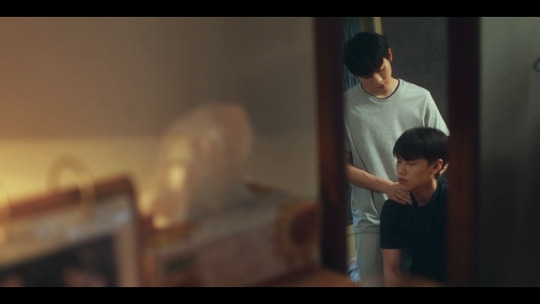
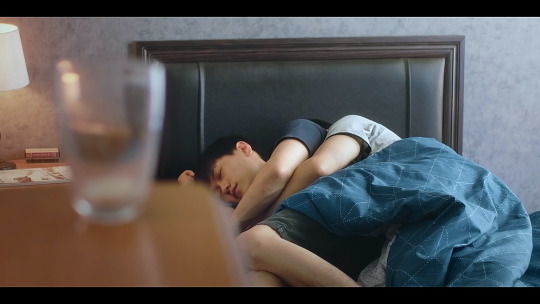
Something that I immediately noticed about Unknown is how much dirty framing it uses. "Dirtying the frame" is when a cinematographer uses architecture, nature, objects, or even people in the foreground to add depth to a shot. In earlier episodes, we often see Qian and Yuan framed together by everyday household objects.
These shots emphasize the uniqueness of their relationship: they are brothers because of the domesticity surrounding them and yet at the same time the framing almost tucks them away into a private space of their own. Their relationship is born from yet separate from the familial space they share with Lilli.

So when Yuan drunkenly confesses his feelings and shatters any lies Qian might have been telling himself about their complex relationship, the camera language loses its earlier intimacy.
We suddenly see more medium and long (versus close-up) clean shots where the characters are surrounded by tons of negative space, isolated from each other.
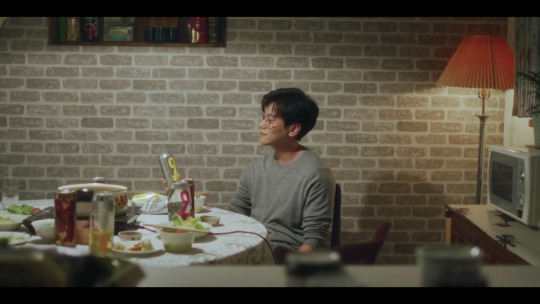
I also don't think it's an accident that we start seeing more dirty frames again once Yuan leaves for America and Qian realizes how much he misses him.
The New Years scene is a perfect example of this. As Qian miserably cheers an absent Yuan, we see the camera subtly pans to the side of the table where he'd usually sit. No one has been able to occupy that private space at home or in Qian's heart.
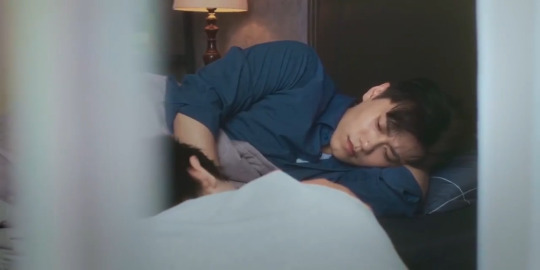
Visual Parallelism
In a previous post, I've talked about how visual parallelism (when we link characters, events, storylines, etc. through a shared image) can signal major changes in the relationship between two characters, and the show uses this technique in multiple ways. (Yuan’s cheeky and completely satisfying “is there something you want me to do?” in Episode 8’s seatbelt scene, for one.)
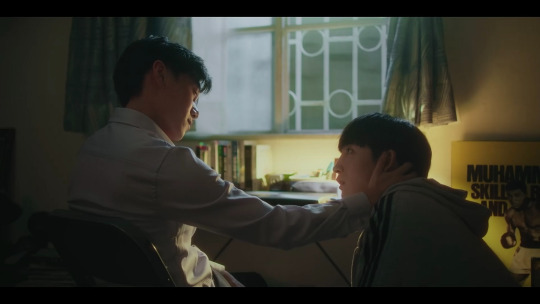
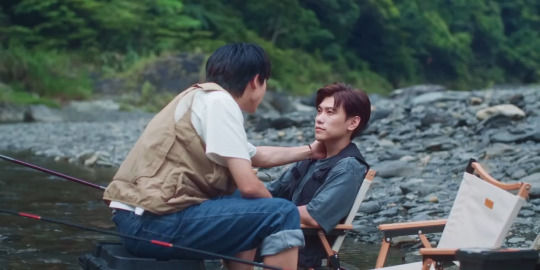
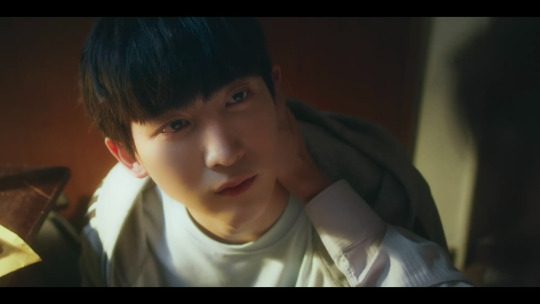

But I think the most striking moment is when Yuan asks Qian to confront his own feelings at the end of Episode 8.
When we look at the composition, camera angles, and actor blocking (how the actors are positioned in relation to one another) we can see that the scene directly mirrors the moment that Yuan gifts Qian with cufflinks in Episode 6. In that episode, Yuan is shot from a high angle, making him look even younger and more vulnerable, while Qian cups his face from above, anchoring him as he tries to give misguided advice:
Qian: I actually feel sorry for you. Isn't it tiring to love him? Yuan: It is. It's so tiring to like someone you shouldn't like. Qian: Then what are you doing? Why are you limiting yourself?
It's notable then that during the last scene of Episode 8, the roles are reversed and the blocking and camera language changes accordingly. Throughout Episodes 7-8, we can see the ways Yuan adopts a more mature approach to his interactions with Qian. He has made it clear that he still cares about him but he will only make another move if Qian clearly expresses his desires. Now it's Qian who is the most unsure and vulnerable, with Yuan anchoring him:
Yuan: Wei Qian, don't you like Wei Zhiyuan? If you do, is it only because we're brothers? This thing about us, is it that you don't want it or that you don't dare?
Like Qian had advised him years ago, Yuan now asks why Qian insists on limiting himself by denying what he wants.
Bonus Parallelism:


Both Yuan and Qian's kiss fantasies mirror each other as well.
361 notes
·
View notes
Text
A Few More Art-Related Vocabulary

Lacquer: Any of a variety of clear or colored liquid coating substances that dries to a hard, durable finish, which can be further polished.
Leading lines: Actual or implied lines within an image that lead the viewer’s eye to another point in the image, or occasionally, out of the image.
Mammoth plate: A large glass plate measuring up to 18 x 22 inches, which is made sensitive to light and is used to make prints.
Marquetry: Numerous small pieces of wood or other materials that fit together like a puzzle and are applied to the surfaces of furniture. Marquetry patterns may be scenic, floral, abstract, or arabesque.
Medium (plural: mediums or media): (a) A material or technique used by an artist to produce a work of art, and (b) the adhesive that carries paint’s pigments.
Milliner: A person who designs, makes, trims, or sells women’s hats.
Negative: An image in which the colors, tones, and highlights are the reverse of those in the original subject. The film negative can be used to make a positive print.
Neoclassicism: The style of the Enlightenment in which artists focused on accounts of filial or national devotion, fidelity, and courage and sought to revive the ideal of classical Greece and Rome in architecture, sculpture, painting, and the decorative arts.
Nonrenewable resource: Natural resource that exists in a fixed amount and is being used up faster than it can be made by nature.
Orientalism: Refers to the imitation or depiction of aspects of Eastern cultures in the West by writers, designers, and artists.
Overmantel: An ornamental panel or structure above a mantelpiece (the protruding, often decorative shelf over a fireplace).
Painterly: Characterized by qualities of color, stroke, or texture perceived as distinctive to the art of painting, especially the rendering of forms and images in terms of color or tonal relations rather than of contour or line.
Pastels (also, fabricated chalks): Dry drawing media made from powdered pigments combined with nongreasy binders.
Patron: A person or group that supports artists or writers, especially by giving money.
Perspective: In art, a technique of depicting objects to convey the appearance of distance or depth on a flat surface. It is part of a mathematical system for representing three-dimensional objects and space on a two-dimensional surface by means of intersecting lines that radiate from one point (one-point perspective), two points (two-point perspective), or several points on a horizon line as perceived by an imagined viewer.
Photographic essay: A story illustrated through photographs, which may or may not be accompanied by text.
Phrygian [FRI-jee-an] cap (also, liberty cap): A soft, red, conical cap with the top pulled forward, worn in antiquity by the inhabitants of Phrygia, a region of central Anatolia. In the visual arts, it represents freedom and the pursuit of liberty.
Pinhole camera: A basic form of camera, usually the size of a shoe box, with a tiny hole for the opening and no lens. Light passes through the hole to form an inverted image on the film emulsion (suspension of one liquid in another).
Point of view: The place from which the viewer sees the landscape, or the place where the artist or photographer was sitting or standing when the picture was made.
Porcelain: A durable, fine-grained, nonporous, and usually translucent white ceramic ware that consists essentially of kaolin, quartz, and feldspar and is fired at high temperatures.
Source ⚜ More: Word Lists ⚜ Part 1 2
#art related#word list#terminology#writing reference#dark academia#spilled ink#writeblr#literature#photography#writers on tumblr#writing prompt#poetry#poets on tumblr#writing inspiration#langblr#linguistics#writing ideas#writing inspo#creative writing#rainbow#art#realism#arkhyp kuindzhi#art vocab#writing resources
68 notes
·
View notes
Text
oh no she's talking about AI some more
to comment more on the latest round of AI big news (guess I do have more to say after all):
chatgpt ghiblification
trying to figure out how far it's actually an advance over the state of the art of finetunes and LoRAs and stuff in image generation? I don't keep up with image generation stuff really, just look at it occasionally and go damn that's all happening then, but there are a lot of finetunes focusing on "Ghibli's style" which get it more or less well. previously on here I commented on an AI video model generation that patterned itself on Ghibli films, and video is a lot harder than static images.
of course 'studio Ghibli style' isn't exactly one thing: there are stylistic commonalities to many of their works and recurring designs, for sure, but there are also details that depend on the specific character designer and film in question in large and small ways (nobody is shooting for My Neighbours the Yamadas with this, but also e.g. Castle in the Sky does not look like Pom Poko does not look like How Do You Live in a number of ways, even if it all recognisably belongs to the same lineage).
the interesting thing about the ghibli ChatGPT generations for me is how well they're able to handle simplification of forms in image-to-image generation, often quite drastically changing the proportions of the people depicted but recognisably maintaining correspondence of details. that sort of stylisation is quite difficult to do well even for humans, and it must reflect quite a high level of abstraction inside the model's latent space. there is also relatively little of the 'oversharpening'/'ringing artefact' look that has been a hallmark of many popular generators - it can do flat colour well.
the big touted feature is its ability to place text in images very accurately. this is undeniably impressive, although OpenAI themeselves admit it breaks down beyond a certain point, creating strange images which start out with plausible, clean text and then it gradually turns into AI nonsense. it's really weird! I thought text would go from 'unsolved' to 'completely solved' or 'randomly works or doesn't work' - instead, here it feels sort of like the model has a certain limited 'pipeline' for handling text in images, but when the amount of text overloads that bandwidth, the rest of the image has to make do with vague text-like shapes! maybe the techniques from that anthropic thought-probing paper might shed some light on how information flows through the model.
similarly the model also has a limit of scene complexity. it can only handle a certain number of objects (10-20, they say) before it starts getting confused and losing track of details.
as before when they first wired up Dall-E to ChatGPT, it also simply makes prompting a lot simpler. you don't have to fuck around with LoRAs and obtuse strings of words, you just talk to the most popular LLM and ask it to perform a modification in natural language: the whole process is once again black-boxed but you can tell it in natural language to make changes. it's a poor level of control compared to what artists are used to, but it's still huge for ordinary people, and of course there's nothing stopping you popping the output into an editor to do your own editing.
not sure the architecture they're using in this version, if ChatGPT is able to reason about image data in the same space as language data or if it's still calling a separate image model... need to look that up.
openAI's own claim is:
We trained our models on the joint distribution of online images and text, learning not just how images relate to language, but how they relate to each other. Combined with aggressive post-training, the resulting model has surprising visual fluency, capable of generating images that are useful, consistent, and context-aware.
that's kind of vague. not sure what architecture that implies. people are talking about 'multimodal generation' so maybe it is doing it all in one model? though I'm not exactly sure how the inputs and outputs would be wired in that case.
anyway, as far as complex scene understanding: per the link they've cracked the 'horse riding an astronaut' gotcha, they can do 'full glass of wine' at least some of the time but not so much in combination with other stuff, and they can't do accurate clock faces still.
normal sentences that we write in 2025.
it sounds like we've moved well beyond using tools like CLIP to classify images, and I suspect that glaze/nightshade are already obsolete, if they ever worked to begin with. (would need to test to find out).
all that said, I believe ChatGPT's image generator had been behind the times for quite a long time, so it probably feels like a bigger jump for regular ChatGPT users than the people most hooked into the AI image generator scene.
of course, in all the hubbub, we've also already seen the white house jump on the trend in a suitably appalling way, continuing the current era of smirking fascist political spectacle by making a ghiblified image of a crying woman being deported over drugs charges. (not gonna link that shit, you can find it if you really want to.) it's par for the course; the cruel provocation is exactly the point, which makes it hard to find the right tone to respond. I think that sort of use, though inevitable, is far more of a direct insult to the artists at Ghibli than merely creating a machine that imitates their work. (though they may feel differently! as yet no response from Studio Ghibli's official media. I'd hate to be the person who has to explain what's going on to Miyazaki.)
google make number go up
besides all that, apparently google deepmind's latest gemini model is really powerful at reasoning, and also notably cheaper to run, surpassing DeepSeek R1 on the performance/cost ratio front. when DeepSeek did this, it crashed the stock market. when Google did... crickets, only the real AI nerds who stare at benchmarks a lot seem to have noticed. I remember when Google releases (AlphaGo etc.) were huge news, but somehow the vibes aren't there anymore! it's weird.
I actually saw an ad for google phones with Gemini in the cinema when i went to see Gundam last week. they showed a variety of people asking it various questions with a voice model, notably including a question on astrology lmao. Naturally, in the video, the phone model responded with some claims about people with whatever sign it was. Which is a pretty apt demonstration of the chameleon-like nature of LLMs: if you ask it a question about astrology phrased in a way that implies that you believe in astrology, it will tell you what seems to be a natural response, namely what an astrologer would say. If you ask if there is any scientific basis for belief in astrology, it would probably tell you that there isn't.
In fact, let's try it on DeepSeek R1... I ask an astrological question, got an astrological answer with a really softballed disclaimer:
Individual personalities vary based on numerous factors beyond sun signs, such as upbringing and personal experiences. Astrology serves as a tool for self-reflection, not a deterministic framework.
Ask if there's any scientific basis for astrology, and indeed it gives you a good list of reasons why astrology is bullshit, bringing up the usual suspects (Barnum statements etc.). And of course, if I then explain the experiment and prompt it to talk about whether LLMs should correct users with scientific information when they ask about pseudoscientific questions, it generates a reasonable-sounding discussion about how you could use reinforcement learning to encourage models to focus on scientific answers instead, and how that could be gently presented to the user.
I wondered if I'd asked it instead to talk about different epistemic regimes and come up with reasons why LLMs should take astrology into account in their guidance. However, this attempt didn't work so well - it started spontaneously bringing up the science side. It was able to observe how the framing of my question with words like 'benefit', 'useful' and 'LLM' made that response more likely. So LLMs infer a lot of context from framing and shape their simulacra accordingly. Don't think that's quite the message that Google had in mind in their ad though.
I asked Gemini 2.0 Flash Thinking (the small free Gemini variant with a reasoning mode) the same questions and its answers fell along similar lines, although rather more dry.
So yeah, returning to the ad - I feel like, even as the models get startlingly more powerful month by month, the companies still struggle to know how to get across to people what the big deal is, or why you might want to prefer one model over another, or how the new LLM-powered chatbots are different from oldschool assistants like Siri (which could probably answer most of the questions in the Google ad, but not hold a longform conversation about it).
some general comments
The hype around ChatGPT's new update is mostly in its use as a toy - the funny stylistic clash it can create between the soft cartoony "Ghibli style" and serious historical photos. Is that really something a lot of people would spend an expensive subscription to access? Probably not. On the other hand, their programming abilities are increasingly catching on.
But I also feel like a lot of people are still stuck on old models of 'what AI is and how it works' - stochastic parrots, collage machines etc. - that are increasingly falling short of the more complex behaviours the models can perform, now prediction combines with reinforcement learning and self-play and other methods like that. Models are still very 'spiky' - superhumanly good at some things and laughably terrible at others - but every so often the researchers fill in some gaps between the spikes. And then we poke around and find some new ones, until they fill those too.
I always tried to resist 'AI will never be able to...' type statements, because that's just setting yourself up to look ridiculous. But I will readily admit, this is all happening way faster than I thought it would. I still do think this generation of AI will reach some limit, but genuinely I don't know when, or how good it will be at saturation. A lot of predicted 'walls' are falling.
My anticipation is that there's still a long way to go before this tops out. And I base that less on the general sense that scale will solve everything magically, and more on the intense feedback loop of human activity that has accumulated around this whole thing. As soon as someone proves that something is possible, that it works, we can't resist poking at it. Since we have a century or more of science fiction priming us on dreams/nightmares of AI, as soon as something comes along that feels like it might deliver on the promise, we have to find out. It's irresistable.
AI researchers are frequently said to place weirdly high probabilities on 'P(doom)', that AI research will wipe out the human species. You see letters calling for an AI pause, or papers saying 'agentic models should not be developed'. But I don't know how many have actually quit the field based on this belief that their research is dangerous. No, they just get a nice job doing 'safety' research. It's really fucking hard to figure out where this is actually going, when behind the eyes of everyone who predicts it, you can see a decade of LessWrong discussions framing their thoughts and you can see that their major concern is control over the light cone or something.
#ai#at some point in this post i switched to capital letters mode#i think i'm gonna leave it inconsistent lol
34 notes
·
View notes